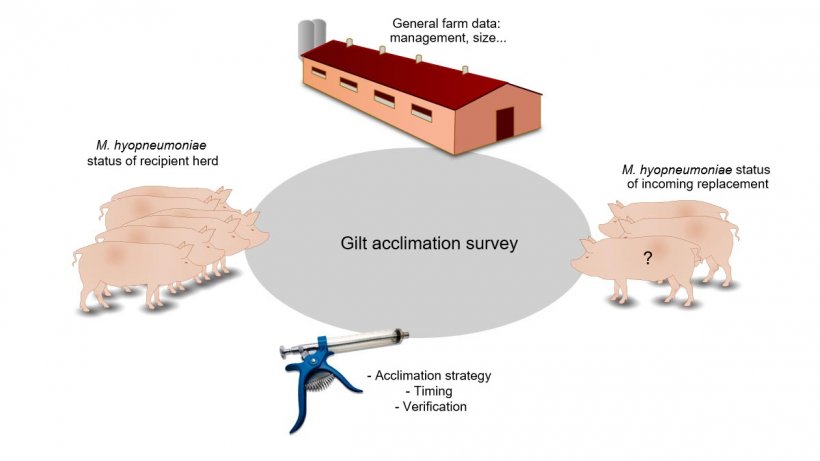Mycoplasma hyopneumoniae (M. hyopneumoniae) is the etiological agent of swine enzootic pneumoniae (EP), a chronic respiratory disease that causes severe economic losses in the pig industry worldwide. These economic losses are due to reduced performance, increased susceptibility to other infections and higher treatment costs (Thacker and Minion, 2012).
Transmission of M. hyopneumoniae is mainly by close contact (nose-to-nose) between infected and susceptible pigs (Maes et al., 1996). Since intra-uterine transmission does not occur, the first chance for M. hyopneumoniae exposure is during the lactation period by direct contact with the sow (Nathues et al., 2016). Moreover, gilts and young parity sows have been determined as the main M. hyopneumoniae adult shedders, so their litters have a higher probability to become infected (Boonsoongnern et al., 2012). Since M. hyopneumoniae colonization at weaning has been correlated with the severity of respiratory problems in the fattening period, it has been proposed that the first farrowing is a key point for controlling M. hyopneumoniae infection (Fano et al., 2007; Pieters and Fano, 2016).

Taking into account that the gilts are the main M. hyopneumoniae shedders at farrowing, strategies focused on decreasing M. hyopneumoniae gilt shedding are required. In fact, it is advised to perform gilt acclimation to reduce the M. hyopneumoniae infectious pressure in a farm. Nevertheless, information available on how M. hyopneumoniae gilt acclimation is performed in practice is limited. Recently, a descriptive study about M. hyopneumoniae gilt acclimation practices at European level was published (Garza-Moreno et al., 2017). This study was based on European swine veterinarian responses from a questionnaire divided in two parts (Figure 1). In the first part, general data such as herd size and production system was collected. The second part included questions concerning different factors that should be considered when planning gilt acclimation:
- M. hyopneumoniae status of recipient herds: This section asked for the current herd status regarding to M. hyopneumoniae and how this farm status was monitored (i.e. clinical diagnosis by presence of cough and lung lesions, laboratorial confirmation by ELISA and/or PCR, both…).
- M. hyopneumoniae status of incoming replacement: This part collected data concerning to the replacement origin, frequency of entrance, age on arrival, health status regarding to M. hyopneumoniae and how this status was checked.
- Gilt acclimation process, timing and verification: This section asked for the replacement management practices, the strategy used to acclimate (vaccines, animal exposure, etc.) and the timing of these practices. Finally, the verification of this process by laboratory techniques was also requested.

A total of 321 survey responses from 108 veterinarians from 18 European countries were obtained, being most responses from Southern European countries (70%). From these 321 participants, 320 (99%) knew the status of their farm in regards M. hyopneumoniae. Such assessment was based mainly on the presence of clinical signs and lung lesions at slaughter (30%). In addition, 87% of the respondents knew replacement status on arrival, being in most of the cases seropositive against M. hyopneumoniae (56%). Nevertheless, only 28% of them checked this theoretical status, being ELISA the most utilized laboratory technique for such assessment.
Gilt acclimation was performed in 78% surveyed European farms; vaccination, alone or combined with natural exposure to infected animals, was the main used strategy (Table 1). Vaccination (with one and two doses) was frequently administered to gilts during the acclimation period. Finally, the results of this study showed that verification at the end of the acclimation process is not frequently performed in Europe; only 24% of respondents checked it.
Table 1. Number of farms (%) according to gilt acclimation strategy for M. hyopneumoniae used in Europe (Garza-Moreno et al., 2017).
| No. methods | Vaccination | Selected sows for slaughter | Pigs | Others | Total | % |
| 0 | 72 | 22.4 | ||||
| 1 | ✓ | 145 | 45.2 | |||
| ✓ | 2 | 0.6 | ||||
| ✓ | 1 | 0.3 | ||||
| ✓ | 1 | 0.3 | ||||
| 2 | ✓ | ✓ | 53 | 16.5 | ||
| ✓ | ✓ | 13 | 4.1 | |||
| ✓ | ✓ | 2 | 0.6 | |||
| ✓ | ✓ | 1 | 0.3 | |||
| 3 | ✓ | ✓ | ✓ | 31 | 9.7 | |
| Total | 243 | 88 | 47 | 2 | 321 | 100.0 |




